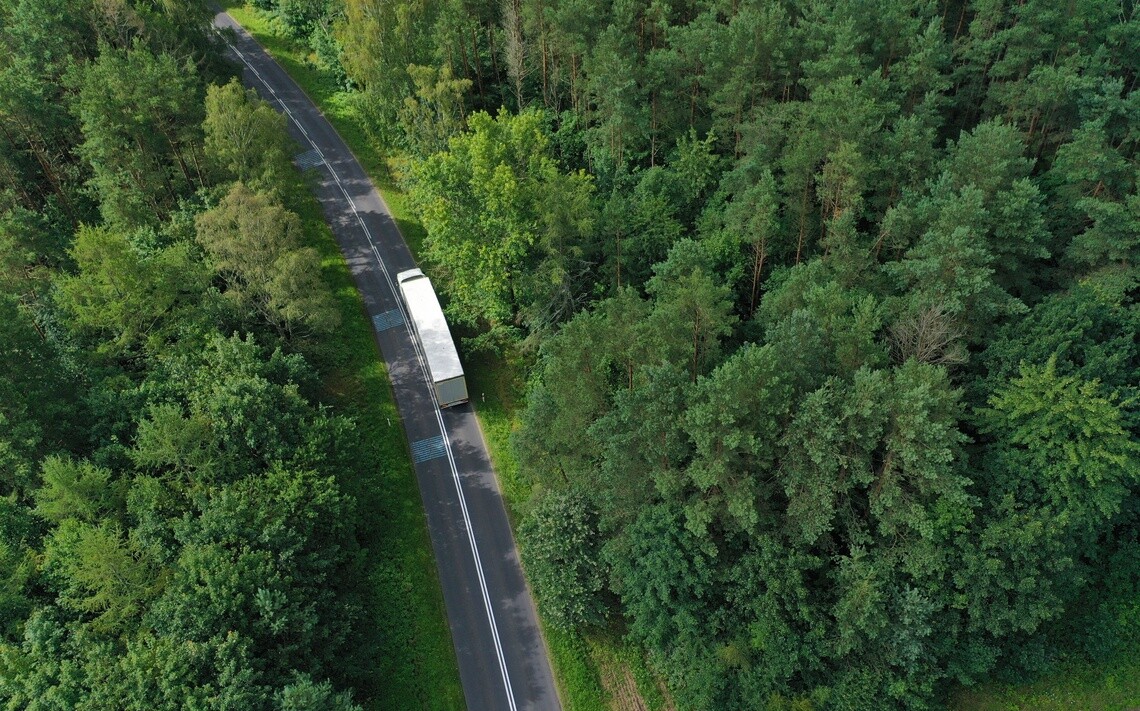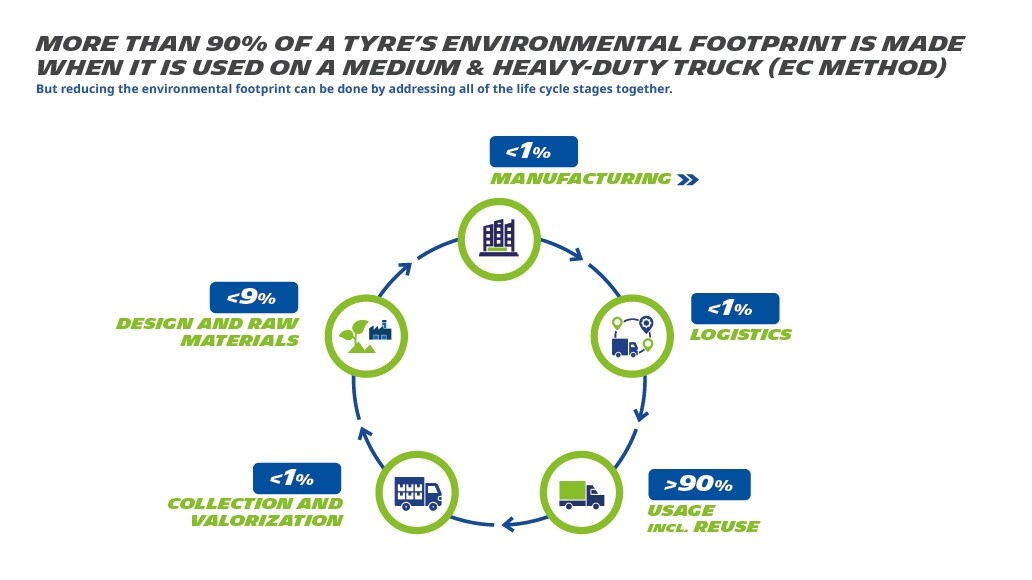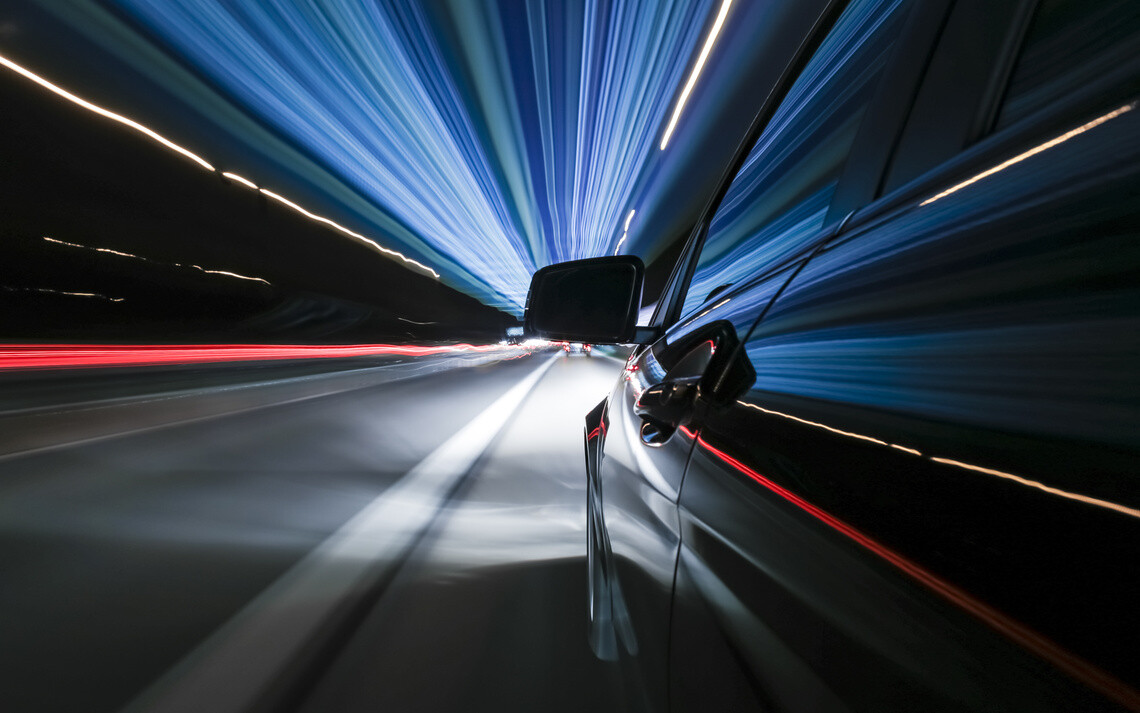
header how to reduce your carbon footprint
Aerial drone perspective view on white truck with cargo trailer riding through the forest on curved asphalt road.
Carbon emissions in transport: basics & outcomes
For the past two centuries, the transport industry has relied heavily on fossil fuels, leaving behind a trail of carbon and other greenhouse gas emissions. When we consider that every litre of fuel a fleet consumes releases 3.24 kilograms of carbon dioxide (CO2)1 into the atmosphere, it’s no wonder that our industry is one of the leading climate change contributors, according to the World Bank2.
We are here to help fleet owners across our industry navigate their way towards more sustainable transport by identifying effective ways to reduce emissions and improve efficiency. After all, the path to net zero extends beyond just tailpipes, it requires organisations to take stock of their entire business and supply chain ౼ encompassing logistics, infrastructure and development choices. We need to work across the industry, meticulously tracking and calculating carbon emissions from transport in order to achieve clean energy goals.
Our top ten tips to reduce your ecological footprint
1. Adopt sustainable practices
A crucial first step towards reducing carbon emissions in transportation is choosing an inventory management strategy that adapts to your fleet's needs today and is flexible and scalable enough to withstand future challenges. Consider options like Just-in-Time (JIT) inventory, which minimises the need for storage space by ordering and receiving supplies only when needed. Vendor-managed inventory (VMI) can also be explored, where suppliers manage your stock levels. Additionally, cycle counting, which involves regularly checking a portion of your inventory, boosts accuracy and control, reducing the risk of overstocking or understocking.
Fleets can further enhance sustainability by reducing packaging waste. This involves using more environmentally friendly materials, optimising packaging design to ensure that products are protected and minimising unnecessary packaging altogether. The benefits of these efforts extend beyond the environment. By reducing packaging waste, you can expect lower material and transportation-related costs. You may even see improvements in workplace productivity once you’ve enhanced supply chain visibility and optimised control over inventory.
2. Route planning and vehicle loading go a long way to reducing carbon emissions in road transportation
There are several ways to shrink your carbon footprint before your fleet even leaves the depot. One surefire way is consolidating shipments ౼ meaning avoiding partially filled pallets and individual orders. This reduces packaging, labour and avoidable mileage. Route planning is another lever. This practice involves prioritising the most fuel- and time-efficient routes, staying up-to-date on traffic, weather and road conditions. These practices not only shrink your overall footprint but can also lead to considerable savings when you factor in time saved and accidents avoided.
How you load your truck is also a key factor in fuel and energy efficiency ౼ which can generate a smaller carbon footprint and savings at the pump. First off, eliminate any unnecessary weight and opt for lightweight materials such as aluminium. Distributing weight evenly inside your truck, which then allows it to be dispersed evenly across all axles, is another way to boost fuel efficiency.
3. Promote eco-driving practices to minimise your carbon footprint
Tried and tested eco-driving techniques, including maintaining a steady speed and minimising frequent acceleration, braking or gear changes, are proven to lower fuel consumption ౼ and thus carbon emissions in road transportation ౼ without impacting overall delivery time. When looking at the life cycle analysis of a tyre, the part that consumes the most CO2 is during use phase. In fact over 80% of a tyre’s environmental footprint is made while driving.3 It is therefore all the more important to implement eco-driving strategies to ensure your tyre is optimised for peak performance.

tyre s environmental footprint
Results from LCA methodology, EC of European commission for a 4*2 tractor + semi trailer 3 axles X Multi, 315/70 , 385/55. March 2024
Integrating comprehensive eco-driving programmes can empower drivers to adopt fuel-efficient driving habits, helping your fleet reach its energy efficiency and sustainability goals. Some fleets even create incentive programs to encourage drivers to reduce fuel consumption, a win for the planet and your bottom line and the global effort to combat climate change.
4. Measure and optimise with a truck carbon footprint calculator
The best way to manage carbon emissions in transportation is to understand the environmental and financial impact of your operations. A truck carbon footprint calculator like Michelin's Sustainability Impact Calculator analyses factors including fuel consumption, tyre choice and average mileage to show fleet managers the positive impact of retreading or regrooving tyres. The calculator highlights savings in CO2 emissions and raw materials used for new tyres. By entering details about your fleet, you can receive a personalised report with carbon footprint transport comparisons that will help you save money and minimise environmental impact.
5. Upgrade to more efficient trailer designs
Aerodynamics can have a huge impact on vehicle drag, which in turn impacts fuel efficiency and your bottom line. Trailer side skirts help to streamline airflow, can reduce drag and boost fuel efficiency by up to 5%⁴. Vented mud flaps are another great addition to your truck ౼ they not only protect drivers and other vehicles from kicked-up debris, but the vented design causes less drag than solid flaps. Some experts estimate that vented mud flaps can lead to 2.7% fuel savings⁵. You can pair these add-ons with rear fairings and nose fairings to boost fuel efficiency even more!
6. Retrofit fleet vehicles
Lowering your carbon emissions doesn't mean that you need to swap out every vehicle in your fleet. Retrofitting helps fleet managers leverage new technology to boost efficiency and comply with new regulations by adding a component to existing trucks. For example, you can integrate a retrofitted electrified propulsion system ౼ with an electric motor and lithium-ion battery pack ౼ as a first step towards long term sustainability and reduced reliance on fossil fuels. This shift not only reduces emissions by as much as 25-50%6, it also avoids abandoning a functioning vehicle and delaying the need for the production of a new vehicle.
7. The important role that tyres play in reducing carbon emissions in transportation
When calculating carbon emissions from transport, tyre choice can make a huge difference. For example, Michelin X® MULTI™ ENERGY™ premium tyres boast long-lasting grip and tread endurance, maximising the time they spend on the road. We also offer regrooving and retreading solutions to extend tyre life even further. In fact, regrooving extends tyre life by 25%, reducing the need for the raw materials and carbon emissions needed to produce new tyres. Retreading goes a step further – it eliminates the need for around 70%7 of the raw materials required for a new tyre, significantly reducing your manufacturing footprint.
8. Tap into telematics and fleet management systems
The right telematics and fleet management systems leverage can improve your environmental impact, safety, and overall efficiency. These systems leverage massive amounts of real-time data collected from sensors placed inside each truck and enable fleets to take an increasingly proactive stance towards route planning, equipment repairs, managing idle time and overall fleet management (see our article on how data insights can optimise your fleet).
The North American Council on Freight Efficiency (NACFE)8 estimates that fleets can save as much as $1,000 per vehicle every year by using telematics to monitor tyre pressures ౼ a benefit that also translates into safer, more cost-effective and more efficient driving.
9. Teamwork & collaboration: engage your drivers to protect the environment
The success of your fleet's sustainability initiatives hinges on engaging your people, especially drivers. Foster a shared vision of how to limit your carbon footprint by communicating your sustainability goals clearly, equipping your workforce with the knowledge and skills to put those goals into action, involving your fleet in the journey and integrating these practices in a lasting way directly into your company culture.
In fact, a study conducted by the Harvard Business Review9 found that companies excel in sustainability efforts because they treat sustainability as a shared responsibility, encouraging everyone to own their responsibilities. And the investment goes a long way, for the planet but also for your fleet. A Gartner study showed that companies who embed sustainability into their company culture can boost employee engagement by up to 43%.10
10. Invest in renewable energy infrastructure to reduce your carbon footprint
Once trucks make their way back to depots and regional distribution centres, there is another opportunity to boost sustainable practices and financial savings. Renewable energy infrastructure is a great way to shrink a fleet's carbon footprint. By installing reliable wind turbines and solar panels, for example, a fleet can generate enough electricity to power onsite operations ౼ including fuel pumps, lighting, heating and cooling. For electric fleets, this also provides a great opportunity to harness renewable energy for extra savings and reduce dependence on fossil fuels.
Studies and examples: Carbon emissions in transportation
• 78% of fleets have set sustainability goals11
• Choosing a tyre that reduces rolling resistance and fuel consumption, results in less CO2 emissions when fitted to a diesel- or gas-powered vehicle.12
• Up to a 25% reduction in fuel consumption when fleets adopt eco-driving practices13
- • 100 tyres retreaded by Michelin saves five tonnes of raw materials14
• 0.8 litres of fuel saved for every 100 km travelled on Grade B low rolling resistance tyres (compared to grade C tyres).15
• 3 - 4% drop in fuel consumption when telematics, fleet management systems and other various connected solutions are implemented.16
FAQs
A carbon footprint is the total amount of greenhouse gases (GHGs), primarily carbon dioxide (CO₂), emitted directly or indirectly by an individual, organization, product, or activity. It’s measured in units of CO₂ equivalent (CO₂e). In transportation, this includes emissions from fuel combustion, vehicle manufacturing, maintenance, and infrastructure.
Adopt sustainable practices, encourage eco-driving, use a carbon calculator, plan your routes and load vehicles properly, integrate telematics and fleet management systems into your operations, consider an electric retrofit, upgrade your trailer, choose the right tyres, invest in infrastructure and get your team onboard.
Heavy-Duty Vehicles (HDV) are responsible for more than a quarter of greenhouse gas (GHG) emissions from road transport in the EU, and for over 6% of total EU GHG emissions16.
According to the European Environmental Agency, Transport is responsible for about 25% of the EU’s total greenhouse gas (GHG) emissions17.
- 1. BILAN GES ADEME
- Base Carbone Documentation generale
- 2. World Bank. Industry, innovation & infrastructure. 2022
- https://datatopics.worldbank.org/sdgatlas/goal-9-industry-innovation-and-infrastructure?lang=en
- 3. Results from LCA methodology, EC of European commission for a 4*2 tractor + semi trailer 3 axles X Multi, 315/70 , 385/55. March 2024
- 4 – 5. Great Dane. How to Improve Fuel Efficiency with Trailer Aerodynamics.
- https://greatdane.com/how-to-improve-fuel-efficiency-with-trailer-aerodynamics/
- 6. Government Fleet. Electrification Retrofits: Helping Fleets Meet Sustainability Goals Despite Supply Chain Challenges.
- https://www.government-fleet.com/10159224/electrification-retrofits-helping-fleets-meet-sustainability-goals-despite-suppl
- 7. Michelin. Optimise your fleet with Michelin Remix retread tyres
- https://business.michelin.co.uk/blog/articles/optimise-your-fleet-with-michelin-remix-retread-tyres
- 8. Trucking Info. How Proper Truck Tire Pressure Saves Fleets Fuel
- https://www.truckinginfo.com/10145680/save-fuel#:~:text=Tire%20pressure%20systems%20are%20projected,
- said%20in%20the%0Confidence%20Report.
- 9. Harvard Business Review. How to Make Sustainability Every Employee’s Responsibility
- https://hbr.org/2018/02/how-to-make-sustainability-every-employees-responsibility
- 10. Gartner Press Release. HR Survey Finds 84% of Employees Believe Their Organization Lacks a Strong Sustainability Culture
- https://www.gartner.com/en/newsroom/press-releases/2023-12-05-gartner-hr-survey-finds-84-percent-of-employees-believe-their-organization-lacks-a-strong-sustainability-culture
- 11. Ducker study – Michelin Fleet Community – June 2021
- 12. Michelin OEM. 0.8L is the average deviation (VECTO value) measured between 2 labelling letters (B compared to C) for a new tyre. Simulation of an average saving over the life of the tyre of 0.6 litres per 100 km between a B-class tyre and a C-class tyre, for a vehicle travelling 150,000 km per year, for a fleet of 50 vehicles, with an assumed price of €1.45 per litre.
- 13. Michelin. Eco-driving : ecological or economic driving? *Average of the results obtained by Michelin from a representative sample of 20 clients in 2022.
- https://business.michelin.co.uk/blog/articles/eco-driving-ecological-or-economic-driving
- 14. Michelin. Optimise your fleet with Michelin Remix retread tyres
- https://business.michelin.co.uk/blog/articles/optimise-your-fleet-with-michelin-remix-retread-tyres
- 15. Michelin OEM. See Source 12
- 16. Michelin. Connected trucks: a way to optimise fleets
- https://business.michelin.co.uk/blog/articles/connected-trucks-a-way-to-optimise-fleets
- 17. European Commission. Reducing CO₂ emissions from heavy-duty vehicles. 2024
- https://climate.ec.europa.eu/eu-action/transport/road-transport-reducing-co2-emissions-vehicles/reducing-co2-emissions-heavy-duty-vehicles_en
- 18. European Environment Agency. Transport and mobility. 2024
- https://www.eea.europa.eu/en/topics/in-depth/transport-and-mobility#:~:text=Today%2C%20transport%20emissions%20represent%20around,
- the%20EU's%20total%20GHG%20emissions.

gettyimages 930571046
car going fast on a road by night





